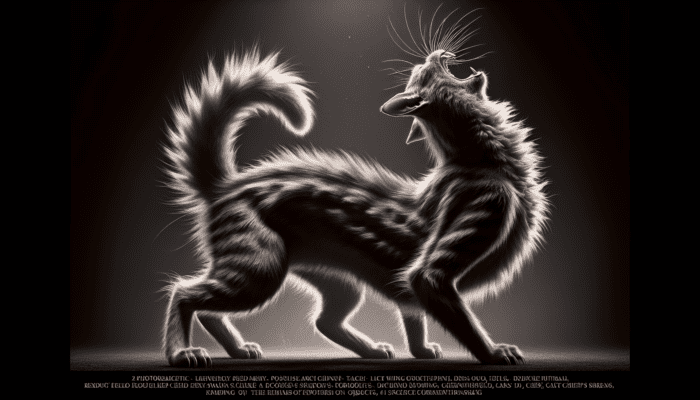Enhance Your Understanding of Your Cat's Behavior for Improved Relationships and Solutions
Are you facing challenges with your cat's behavior? If your furry friend is displaying unusual actions or habits, it is vital to explore the root causes of these behaviors. Dive deep into the intricacies of cat body language and discover effective strategies to soothe a nervous cat. By understanding your cat’s needs and emotional states, you can nurture a harmonious relationship that significantly improves the quality of life for both you and your cherished pet.
Decoding Cat Communication: Mastering the Signals of Body Language

The methods by which cats communicate are intricate and layered, making it essential for cat owners to familiarize themselves with their body language. Understanding these non-verbal signals can greatly enhance the bond between you and your feline companion. By identifying the subtle cues indicating whether your cat feels content or prefers solitude, you can create a nurturing environment tailored to her preferences, fostering a more enriching companionship that benefits both parties involved.
Unlike dogs, which exhibit a wider array of facial expressions due to their more diverse facial muscle structures, cats convey their emotions more subtly. Therefore, it is crucial to pay attention to even the slightest shifts in their body language, as these small nuances can reveal a wealth of information about their feelings, mood, and overall mental state.
Recognizing the Signs of a Happy and Relaxed Cat
Nothing compares to the joy of observing a happy cat! There are several unmistakable signs that indicate your feline friend is feeling content and comfortable in her surroundings. These signs include:
Tail Position: When your cat approaches you with her tail held high, often with the tip curled, it typically signifies a warm greeting and a clear indication of her happiness. This posture demonstrates that she is glad to see you and feels secure in your presence, allowing for a stronger bond.
Relaxed Eyes: A comfortable cat will have eyes that are not wide open and alert but may instead be gently closed or shaped like a rugby ball. This relaxed eye position is a strong indicator of her comfort level and emotional well-being, suggesting she is at peace in her environment.
Slow Blinking: Cats often use slow blinking as a means of conveying friendliness. When you reciprocate by blinking slowly and gently averting your gaze, it reassures your cat that you pose no threat and are a trustworthy companion, which can enhance your mutual understanding.
Exposing the Belly: If your cat rolls onto her back and reveals her tummy, it is a sign of trust and relaxation, rather than an invitation for a belly rub! Instead, carefully pet her head to avoid any unexpected scratches from her sharp claws, showing affection while respecting her boundaries and comfort.
Playful Leaps: When your cat jumps up to greet you, it is a clear invitation for affection and interaction. Ignoring this gesture would be considered impolite, as it signifies her desire for connection and engagement with you, reinforcing your bond.
Understanding Signs of Stress or Anxiety in Your Cat
Various factors can trigger stress or anxiety in our feline companions, ranging from encounters with other animals to unfamiliar noises, such as the sound of a washing machine. Common signs indicating a stressed cat include:
If your cat is crouched low to the ground, she may be attempting to hide from perceived threats. Providing her with a safe space is crucial, as every cat needs a sanctuary where she can retreat when feeling vulnerable, ensuring her emotional comfort and security.
Flat Ears: When a cat flattens her ears against her head, it is a clear sign of agitation or discomfort. This posture indicates that she feels threatened or uneasy, and it is essential to respect her feelings during such moments to ensure her well-being.
Wide Eyes: If your cat's pupils are dilated and her eyes appear wide open, this indicates heightened alertness and anxiety. Stressed cats may prefer to hide rather than seek your company, making it vital to acknowledge and respect their need for space during these challenging times.
Recognizing When Your Cat Feels Threatened and Appropriate Responses

Cats are naturally territorial creatures, and their body language can shift dramatically when they feel threatened. Be observant of the following behaviors:
Arched Back: A frightened cat will arch her back, trying to appear larger and more intimidating to potential threats. This posture serves as a defense mechanism to deter perceived dangers, showcasing her instinctual responses.
Tense Tail: When a cat is scared, her tail may be held upright and tense, reflecting her state of anxiety and readiness to react to any threats in her surroundings, indicating her emotional distress.
Whiskers and Fur: In response to perceived threats, a cat's fur may stand on end, and her whiskers will point forward, directed towards the object of her fear, enhancing her awareness of the situation and increasing her alertness to potential dangers.
Extremely anxious cats might hiss or even strike out at whatever is causing their distress. Instead of approaching them, it’s wise to assess the situation from a safe distance and, if possible, identify the source of their fear before intervening, ensuring their safety.
Enhancing Communication with Your Cat Through Body Language Interpretation
It is entirely possible to engage in a meaningful dialogue with your cat by learning to interpret her body language effectively. One essential tip is to avoid direct eye contact, as this can be perceived as a threat, causing her to feel frightened and unresponsive to your presence, which can hinder communication.
You can convey your understanding and create a relaxed atmosphere by acknowledging her comfort level through your own body language. If she appears calm, try slowly blinking at her while gently tilting your head. If you’re fortunate, your cat may mirror this behavior back to you, strengthening your bond and enhancing your relationship.
Using harsh vocalizations, such as calling your cat with a sharp “ss,” can irritate her, as she may interpret it as a hiss, which could be perceived as rude and confrontational. Being mindful of your tone and approach can foster a more positive and constructive interaction.
Exploring the Multifaceted Meaning of Your Cat's Purring: Beyond Just Contentment
When our cats purr, we often associate this soothing sound with happiness and contentment. While this is indeed true, it is vital to consider their overall body language, as purring can also serve multiple purposes. Cats may purr when they seek your attention or when they feel bored and require stimulation.
Interestingly, cats may also purr in stressful situations, such as during a trip to the vet. However, this doesn’t always mean they are relaxed; at times, they may purr when they are experiencing discomfort or pain, signaling a need for care and attention from you.
By closely observing your cat's body language and considering the context of her purring, you can gain a clearer understanding of her emotional state and overall well-being. Recognizing these signals will empower you to respond more effectively to her needs, fostering a deeper and more meaningful connection.
The Article: Do You Have Problems With Your Cat’s Behaviour Appeared First On Unity Pets.
The Article Cat Behavior Issues: Solutions for Your Feline Friend Was Found On https://limitsofstrategy.com
The Article Cat Behaviour Solutions for Common Issues with Your Feline First Appeared ON
: https://ad4sc.com





No responses yet